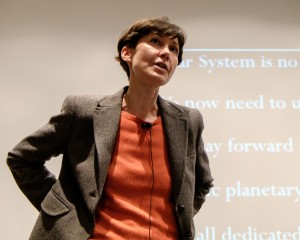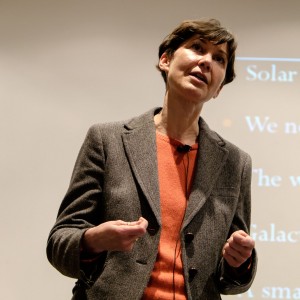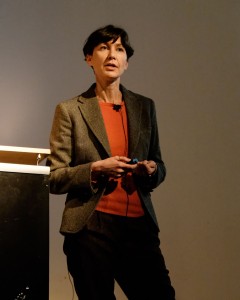January 12, 2015
Galactic Planetary Science
Professor Giovanna Tinetti
Report by: Andy Sawers
Galactic Planetary Science: What we’re learning about exoplanets and their atmospheres
Professor Giovanna Tinetti, professor of Physics and Astronomy at University College London
It’s not very many years since the first discoveries of exoplanets, planets outside our own solar system, and yet today there is already some very impressive work being done to analyse the size, orbits and even the atmospheres of these far off worlds, as Prof Tinetti explained. Report by Andy Sawers.
About 2,000 planets have been discovered in our galaxy orbiting stars other than our Sun, said Giovanna Tinetti. But it’s not just the number of planets discovered that is revolutionary. The characteristics of these newly-discovered planets have been surprising. Before we discovered these other planets, we used to think that, around their stars, these planets would somehow resemble the planets in our own solar system. But that’s not been the case.
The Kepler mission, launched in 2009, not only detected new planets but allowed us to measure their size. Giovanna displayed a scattergram chart showing planets’ distance from their stars on the X axis and their mass on the Y axis. What it shows is that, in our solar system, the less massive rocky planets are well separated from the gas giants and the icy giants, which are far away from the Sun.
But in exosystems we see large planets that are “literally almost sitting on their star”, Giovanna said. They are orbiting their star with a period that’s a fraction of what we see in our own solar system. In some cases, an orbital period of just a few days.
And of course the closer you are to the star, the higher is the temperature on the planet. For those planets that are located very close to their star the temperature can be extremely hot: 2000oC or even 3000oC – iron melts, gold melts.
70,000 new exoplanets?
“Fasten your seatbelt for the next decade,” she said. “We have a long list of space missions and ground-based missions that will increase the number of known planets by another order of magnitude.” ESA’s Gaia, for example, launched last year to map a billion stars, is predicted to discover about 70,000 new exoplanets.
“Our solar system doesn’t seem to be representative – there is much more variety than the planets around our own star,” Giovanna said. For one thing, we are seeing many planets orbiting around binary stars so for those planets it might be quite interesting to have two dawns and two sunsets!
We also have planets which are going around their star in orbits which are very eccentric. One example is HD80606b (click here for a demonstration of its orbit and here for a fascinating BBC report) whose was observed using the UCL observatory at Mill Hill. Its orbit has an eccentricity of around 0.9 which is comparable with that of comet Halley. As it gets very close to its star it reaches very high temperatures, then moves much further away during the rest of its orbit.
So the key questions we want to try to address in coming years are, why is the solar system not representative of the planetary systems in our galaxy? What are the causes of the diversity? And are there habitable planets?
We know the mass of some exoplanets as well as their size (radius), so we can then calculate their density. Plotting this data for smaller planets on a chart shows that our models currently fail to tell us what these planets are made of because the error bars are too great. We don’t really know from their density what is happening up there.
Up in the air
So – how to proceed? Looking at an exoplanet’s atmosphere and in particular its composition gives us insight into the main physical and chemical processes. If we know what the atmosphere is made of we might be able to trace back to some of the physical processes and understand what is going on.
Looking at our own solar system, for example, Venus today may have a negligible amount of water vapour but we believe that in the past Venus hosted some oceans such as on the Earth, and then water vapour was lost over time because water evaporated and there was no ‘trap’ like Earth’s clouds that kept water vapour in the lower region of the atmosphere.
On a terrestrial type of planet there might be some volcanic activity which can outgas water vapour, CO2, or CO.
When the Earth was formed the amount of oxygen in the atmosphere was very low and we know this because the analysis of some very old rocks allows us to work out the fraction of oxygen in the atmosphere in the past. When the first micro-organisms were formed on Earth about 3.8 billion years ago, oxygen levels were negligible. Eventually some of these organisms “realised how to use oxygen as a metabolic reactant” and that was the key for the evolution of complexity on Earth: that’s because oxygen as a reactant can be extremely powerful and generate a lot of energy. So as soon as oxygen was produced and used for metabolism on Earth, more and more complex organisms started to evolve.
In the 1960s we saw for the first time what Earth looks like from space in terms of a spectral analysis of our atmosphere. In the 1980s, with Voyager, we started to learn about the outer planets’ atmospheres and about Titan’s, one of Saturn’s moons.
Spectral analysis
Recently we’ve started to be able to analyse the spectrum of exoplanets’ atmospheres, but being tens of light years away the data can’t match what we have for Titan. But for planets that are transiting their star we can extract the composition of the atmosphere by looking at the light coming from the star, filtered by the atmosphere at the limb.
It’s clearly a difficult job – even for space telescopes – because most of them were not really built for these kinds of measurements. But for the planets for which we can do this, the information we can extract is very useful. We can work out whether some of the starlight is being scattered by particles in the atmosphere and work out the size and the distribution of those particles. We can work out whether the atmosphere is very compact or extended, which gives us information about the temperature and the gravity of the planet. And we can also work out the most important thing, the atmospheric composition.
Giovanna gave an example of HD189733b, a so-called ‘hot Jupiter’ – a gas giant located very close to its star. Using information gathered at different wavelengths, from UV to the visible to the infrared, measurements matched against the theoretical models suggest that there is water vapour, methane, and some carbon monoxide present in the atmosphere.
One part in 10,000
As difficult as it is to get measurements for hot Jupiters, it’s more difficult still for smaller objects such as ‘super earths’ and for cold planets: the colder the planet, the more compact the atmosphere and so the more difficult it is to get measurements.
The method used above relies on finding out how the light spectrum changes when the exoplanet passes in front of its star (remember that telescopes can’t resolve the planet from the star, but can see the light coming from the combination of the two). However, there is also a technique to analyse the light coming from the star and its planet and then to compare that with the star alone when the planet passes behind the star. From this we can get the light that is reflected directly by the planet. It’s a difficult measurement “because we’re talking about 1 part in 10,000”, Giovanna said.
In the visible spectrum we can get information about the albedo – the light from the star which is bounced back by the atmosphere or the surface of the planet, which may suggest the presence of clouds. In the infrared we may be able to “see” molecules that have a strong signature in the infrared, such as water vapour, hydrocarbons, and nitrogen.
Another method is to follow the planet throughout its orbit in a process called “phase through”, following a planet as it transits a star, then continues orbiting and is then eclipsed by the star. Measurements have also been taken of planets that don’t actually transit their star: their thermal illumination through their phases is strong enough to be captured by current telescopes.
Where we are today
Giovanna outlined some of the difficulties faced by galactic planetary science today. “We are still dealing with a very low signal compared to noise, so this is very difficult when we are trying to interpret those spectra,” she said. “Probably a new generation of telescope might address some of this. But there are still a lot of problems: we are not covering enough wavelength coverage.”
Also, we aren’t always able to make measurements at different wavelengths simultaneously. “When you want to put together multiple measurements it is a problem if you are not taking measurements at the same time.”
Current instruments are not really calibrated at the level of one part in 10,000. So the brighter the star the better the data – and we would like to have observations of more objects and not just a handful from which to draw some conclusions.
“What I and my colleagues have been advocating is to go for a dedicated mission to look at these atmospheres,” she said. “We don’t need to have a very sophisticated telescope, we just need a light bucket – but we need it to be in space.” A one-metre telescope in space is good enough to do spectroscopy provided the telescope is very stable.
For the last few years they have been working on a concept called EChO – Exoplanet Characterisation Observatory. A UK-led mission, it would have positioned a telescope at the L2 Lagrange point, 1.5m km away from Earth in the “anti-sunward” direction. In 2011 it was shortlisted by the European Space Agency to be one of the medium-class mission candidates for potential launch in 2020-22, but last year it was not selected for launch, losing out to the PLATO mission.
Twinkle, twinkle
“So we started to look at other opportunities,” Giovanna said. “What we came up with was a mission concept called Twinkle.” It would be a British mission – not UK-led but UK-made. The idea is to try to do things much faster and cheaper than through ESA. Twinkle would be able to address all the key questions, do spectroscopy on exoplanets, concentrating between the visible part of the spectrum and the infrared: “We will be able to find out whether there are clouds, how the star is behaving and so on.”
The concept was put together just in the month before Giovanna’s talk by a consortium of UCL and Surrey Satellite Technology. It will be the first mission dedicated to analysing exoplanets’ atmospheres, “and will give us a completely new picture of what these worlds are really like,” Giovanna said. It will be able to determine the ratio between carbon and oxygen so can give us a lot of information about how the planet formed and evolved.
Twinkle will have a 50cm telescope but since most of the stars it will look at are very bright, that will be big enough. The good news is that it will be less than 10% of the usual £500m-600m cost of an ESA M-class mission because it will use all off-the-shelf components – there will be no development costs.
Twinkle will be in a polar low Earth orbit so one challenge is to make sure that the telescope never looks towards the Sun. “But we have looked into this and there is absolutely no problem,” she said. It will be more sensitive to planets located close to the ecliptic. Fortunately, so far, most planets that have been discovered by transit are close to the ecliptic.
“Planetary science, until a few years ago, was just related to objects that were inside the Kuiper belt – limited to our solar system,” Giovanna concluded. “The fact that today we are already thinking in terms of planets in our galaxy is a huge step forward. I hope to see a small dedicated mission being launched in the next few years.”
Pictures from the Evening (by Mike Meynell):
Posted under: Flamsteed, Flamsteed Lecture, Meeting Report








You must be logged in to post a comment.